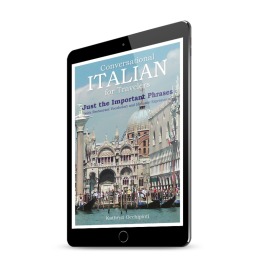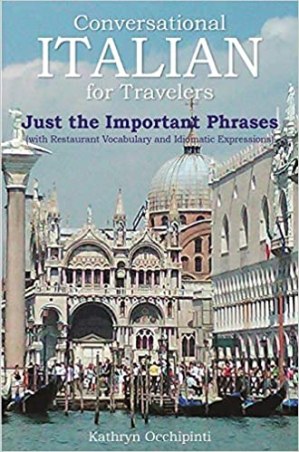
Do you want to speak Italian more easily and confidently in 2024?
Have you set a goal to learn Italian? I will try to help you by posting a new blog every month in the series “Italian Phrases We Use EVERY Day!”® With these blogs, I discuss how Italians use their language on a daily basis and in so doing help you to “think in Italian.”
For instance, many Italian verbs have a similar use to those in English, which simplifies translation from one language to the other. However, often the meaning of an Italian verb will vary from the usual English connotation. And in many situations, the same verb can have several different meanings in both languages, depending on the context. Dovere is an essential Italian verb that you “have to” learn to use in all its shades of meaning if you want to speak like a native Italian!
Dovere, which means “to have to,” or “to must” is one of the three helping verbs in Italian, along with volere (to want) and potere (to be able to/can). We have discussed how important it is to use the verb vorrei (from volere) to be polite as visitor in Italy with the blog, “Italian Travelers – Use ‘Vorrei’ to say, I would like.” We’ve also discussed potere, an essential verb of politeness when used in its third person, present tense conjugation può, in the blog, “Italian Travelers – Use ‘Può’ to ask for what you need!” Also important for the student new to Italian: if you learn how to preface a request politely with può, you can avoid the need to conjugate the main verb of the sentence, since helping verbs are always followed by an infinitive verb!
The third Italian helping verb, dovere, which is the subject of this blog, also fulfills an essential role in everyday Italian life, whether one is a traveler or is speaking to an acquaintance, friend, or family. Dovere is used as a helping verb to emphasize the obligation or the need to complete an action with its meanings of “to have to,” or “to must.” Think of how many times a day we say we “have to” or “must” do something — leave for work or school, run an errand, meet a friend we haven’t seen in awhile — the permutations are endless!
Take the feeling of obligation that one feels when they “must” do something a step further, and the meaning of dovere used as a stand-alone verb changes to “to owe,” or “to be indebted to.” Finally, continuing along these lines, “dovere” is also used as a noun to refer to one’s “duty” or “obligation.”
As I’ve said before, I believe that “commonly used phrases” are the key for how we can all build fluency in any language in a short time.
If we learn how to incorporate “commonly used phrases” when use the Italian verb dovere, we will be able to communicate just as we do in our native language!
This post is the 77th in a series of Italian phrases we have been trying out in our Conversational Italian! Facebook group. If you’d like to read the earlier posts in the series, “Italian Phrases We Use EVERY Day!” just click HERE.
Many “commonly used phrases” in Italian
use the verbDovere
so one can express what they “have to” or “must do.”
See below for how this works.
As we all master these phrases, so will you. Try my method and let me know how it works. What sentences will you create with these phrases?
Please reply. I’d love to hear from you! Or join our Conversational Italian! group discussion on Facebook.
The basics of the Italian language are introduced in the Conversational Italian for Travelers textbook and reference books Just the Verbs and Just the Grammar
found on amazon.com and Learn Travel Italian.com.
The rights to purchase the Conversational Italian for Travelers books in PDF format on two electronic devices can also be obtained at Learn Travel Italian.com.
************************************************
The Italian Verb Dovere
As mentioned above, the helping verb dovere fills an essential role in everyday life, whether one is a traveler to Italy or is speaking to an acquaintance, friend, or family. Dovere is used as a helping verb to emphasize the obligation or the need to complete an action with its meanings of “to have to,” or “to must.” Think of how many times a day we say we “have to” or “must” do something — leave for work or school, run an errand, meet a friend we haven’t seen in a while — the permutations are endless!
Also, it is important to note that in English we often say, ” I need to,” rather than the more formal, “I must,” or even the conversational “I have to,” when in truth, this need is actually an obligation. We might say, “I need to leave for work,” as a stand-alone statement, or with a qualifier, such as “right now,” “soon,” or “at 8 AM.” This type of English statement communicates that one will be leaving due to an obligation. Italians are more specific, though. When their action is a result of an obligation, something they truly need to do because they must do it, Italians use the verb dovere.*
Take the feeling of obligation one step further, and the meaning of dovere used as a stand-alone verb changes to “to owe,” or “to be indebted to.” Finally, continuing along these lines, dovere is also used as a noun to refer to one’s “duty” or “obligation.”
Since the number of ways dovere can be used in conversation is endless, the focus of this blog is on how to use dovere while traveling and in every day interactions.
* If you need a refresher on when Italians would say, “I need” in Italian, visit our blog in this series, “How to say, ‘I need…’ in Italian with ‘Ho bisogno di,’ ‘Mi serve,’ and ‘Averne voglia.'”
How to Conjugate Dovere
Dovere is an irregular -ere verb in the present tense due to its irregular stems — with two irregular stems each for the io and the loro conjugations. The more commonly used stem is listed first in the table below. Only the voi form has a regular stem and ending and is printed in green.
In general, a speaker tends to focus on what he or she “must” or “needs to” do, so the io (I) conjugation will be used the most often. When speaking to a group, the third person plural, noi (we) form dovere is also important to remember. Dovere is such an essential verb, though, it is recommended that all conjugations be memorized!
| io | devo, debbo |
| tu | devi |
| Lei/lei/lui | deve |
| noi | dobbiamo |
| voi | dovete |
| loro | devono, debbono |
Knowing how to conjugate dovere is only the first step if you want to express what you “have to” or “must” do in Italian. After “I have to,” another verb is needed to express what needs to be done — to go somewhere, to buy something, etc. Here is how to link dovere to another verb:
First conjugate the verb dovere to reflect the speaker. Then simply add the infinitive form of the main verb in the sentence after the conjugated form of dovere. This is the same as we would do in English! The verb dovere is known as a modal, or helping verb for the way that it modifies, or adds to, the meaning of the main verb in the sentence.
Two examples below demonstrate how this works. Notice that the subject pronoun io is not included in the Italian example sentences below that use dovere, since subject pronouns are almost always left out of Italian sentences. For this reason, “I” is given in parenthesis in the English translation.
(Io) Devo andare in Italia per lavoro la prossima settimana.
(I) have to go to Italy for work next week.
(Io) Devo tornare lunedì.
(I) have to return Monday.
Dovere with reflexive verbs:
If dovere* is used to modify a reflexive verb, one of the reflexive pronouns (mi, ti, si, ci, vi, si) will be attached to the infinitive form of the reflexive verb or can be placed at the beginning of the phrase, before dovere. The Italian subject pronoun. as usual, has been omitted in the Italian sentences that demonstrate this below, so it is given in parentheses.
(Io) Devo svegliarmi alle sei domani.
I need to (must) get (myself) up at 6 AM tomorrow.
(Io) Mi devo svegliare alle sei domani.
I need to (must) get (myself) up at 6 AM tomorrow.
Notice that the English translation for the examples with [dovere + svegliarsi] is “I need to,” since “I need to” is commonly used by English speakers to describe when they have set an alarm to get up in the morning. This case demonstrates a situation in which Italians use dovere to express a need; there is the understanding is that the speaker must have an underlying obligation that requires a timely awakening.
Past tense:
Passato Prossimo: The past participle is regular, and is dovuto.
When dovere used alone, such as to say, “I owed…/ I have owed…” the helping verb is avere. (However, the imperfetto is more commonly used to describe an indefinite amount of time in the past that one has owed something to another.)
When dovere is used as a helping verb, for instance to say, “I had to…” things get a bit complicated. Either avere or essere can be used; the choice of avere or essere will depend on the main verb.**
1.) If the main verb takes avere in the passato prossimo, the sequence with dovere acting as a helping verb is: [conjugated avere + dovuto + infinitive main verb].
2.) If the main verb takes essere in the passato prossimo, the sequence with dovere acting as a helping verb is: [conjugated essere + dovuto(a, i, e) + infinitive action verb]. Notice that the ending of the past participle dovuto will change to reflect if the speaker is masculine (o,i) or feminine (a,e).**
3.) If the main verb is essere (to be), such as, “I had to be…” the sequence with dovere acting as a helping verb is: [conjugated avere + dovuto + essere].
Imperfetto: Dovere has a regular conjugation in the imperfetto past tense (dovevo, dovevi, doveva, dovevamo, dovevate, dovevano).
*This rule holds true for all modal verbs.
**These rules hold true for all modal verbs.
1. Use dovere with the meaning “to have to” or “must,” to describe an obligation and create complex sentences in Italian.
- As noted in the introduction, verb dovere is used to express a necessity, obligation or duty.
- In grammatical terms, dovere, along with the verbs potere and volere, are referred to as modal verbs. The alternate, name for these verbs, as mentioned above for dovere, is “helping verb,” since modal verbs “modify” the main verb in the sentence and in so doing aid in understanding the situation under discussion. A by product of using a compound verb created with a modal verb is a sentence that has a more complex meaning than a simple sentence.
- In the present tense, a modal verb is conjugated to reflect the speaker and the main verb follows directly after in its infinitive form. This format was discussed with dovere in the last section. (For a discussion of the other helping verbs potere and volere, see “Italian Travelers – Use ‘Può’ to ask for what you need!” and “Italian Travelers – Use ‘Vorrei’ to say, I would like.”)
- Remember to leave out the Italian subject pronoun when creating a sentence with dovere and the other modal verbs, as is usual for Italian conversation. The conjugation of the modal verb will signal who is doing the talking!
- Follow the progression of sentences in the examples below and notice how the modal verbs dovere, potere, and volere allow the individual to express complex ideas by adding bits of information about the action verb in the sentence. In the first sentence, which is a simple sentence, we learn only that someone goes to Rome every day. In the sentence that follows, with the addition of dovere, we learn about the person’s obligation to go to Rome. This brings up the question of “why” this individual “must go” to Rome every day, which is answered with the addition of a short phrase in the same sentence. We also learn how it is possible that this person “can” go to Rome on a daily basis with the addition of potere. Finally, with the helping verb volere, we discover that the individual actually “wants” to go to Rome frequently. Read on and see how to make more complex and descriptive sentences using dovere and other Italian modal verbs!
(Io) Vado a Roma ogni giorno.
I go to Rome every day.
(Io) Devo andare a Roma ogni giorno per lavoro.
I have to (must) go to Rome every day for work.
(Io) Posso andare a Roma ogni giorno; è facile con il treno diretto.
I can go to Rome every day; it is easy with the direct train.
(Io) Voglio andare a Roma ogni giorno; mi piace molto la città!
I want to go to Rome every day; I really like the city!
- The conjugated forms of dovere can also stand alone as a complete sentence to express obligation as, “I must,” “You must,” “He/She must,” and so on. This occurs mostly in conversation, in response to a subject already under discussion. See the last question/answer example below.
(Tu) Devi andare a Roma ogni giorno per lavoro?
Do you have to go to Rome every day for work?
Si, devo.
Yes, I have to. / Yes, I must.
2. Use dovere with the meaning “to have to” or “to must,” to ask about a necessity during transactions or when asking for directions.
- Dovere is often used when performing complex transactions that require an exchange of information, such as when making a purchase that comes with requirements or restrictions. In this case, one may ask about the details that are “necessary” to know about the purchase using dovere. For instance, when purchasing train tickets, there are generally several options to consider. See the first set of example phrases below, which uses both volere and dovere.
- The traveler asking for directions might hear dovere in the response for they “need to do” to reach their destination. See the second set of examples below.
- Other situations in which someone might ask what they “have to do” might involve making an expensive purchase, such as buying a house or a car, or filling out an application, such as for college, a club, or a job. The number of situations in which to use dovere to express necessity is endless!
| Desidera? Desidero un biglietto per Milano. |
What do you want/need/wish? (polite) I want a ticket for Milan. |
| Vorrei un biglietto per Milano. | I would like a ticket for Milan. |
| Vorrei un biglietto di andata e ritorno. | I would like a round trip ticket. (lit. a ticket of going and returning) |
| Vorrei il diretto. | I would like a direct train (non-stop train). |
| Voglio prendere il treno diretto. | I want to take the direct train (non-stop train). |
| Voglio prendere il treno diretto per Milano. | I want to take the direct train for Milan. |
| Devo pagare il supplemento? | Must (I) pay an extra fee (for fast trains)? |
| Vorrei il locale. | I would like the local (many stops on the route). |
| Cambio/Cambi treno a… | I/You change train(s) at… |
| Non vorrei cambiare treno. | I don’t want to change train(s). |
| Devo cambiare treno? | Must I change trains? |
| Quanto ci vuole per la coincidenza? | How much time is needed for the connection? |
| Ho/Abbiamo bisogno di indicazioni. | I/We need directions. |
| Ho/Abbiamo bisogno di un’informazione. Ho/Abbiamo bisogno di informazioni. Ho/Abbiamo bisogno di alcune informazioni. |
I/We need information. (one fact) I/We need information. (more than one fact) I/We need some information. |
| Sa come arrivare a…? | (Do) you (pol.) know how to get to…? |
| Vado bene per…? | Am I going the right way for…? |
| No, sta andando nella direzione sbagliata. | No, you are going in the wrong direction. |
| È lontano da qui? | Is it far from here? |
| È vicino da qui? | Is it close to here? |
| Quanto dista? | How far is (it)? |
| Quanto dista da…? Quant’è lontano da…? |
How far is (it) from…? |
| A quanti chilometri è da…? | How many kilometers is it from…? |
| Quanto tempo a piedi? | How long (walking) on foot? |
| Deve camminare per un’isolato. | You must walk for one block. |
| Deve seguire per… | You must follow for… |
| Deve proseguire per… | You must continue for… |
3. Use dovere in common expressions that describe the necessity of what you “have to” or “had to” do during a typical day.
- The following phrases that use dovere and fare will come in handy when talking about the necessity of the actions you perform during a typical day; that is, what you “have to” or “had to” do. Since fare means “to do,” to create a sentence in the present tense, just place the conjugated form of dovere before the infinitive verb fare.
- In the past tense, to talk about what you did have to do recently, the formula that incorporates dovere and fare is [conjugated avere + dovuto + infinitive main verb], as given earlier in this blog in the section “Conjugation of Dovere.” You may recall that in the passato prossimo, the verb fare always takes avere, which makes the choice of avere in this situation easy! (If you need a refresher on how to create the passato prossimo, visit the blog in this series “Past Tense Passato Prossimo, ‘Avere’ or ‘Essere'”?)
- When you have to leave someone’s company, use the last two popular phrases in our example list that mean, “I’ve got to go!” or in colloquial English, “Gotta go!” or “Gotta run!” To really sound like an Italian, when leaving the company of a close friend, add a phrase of assurance that you’d like to meet again soon with, “A dopo!” for “See you later!” or “A presto!” for “See you soon!”
| Devo alzarmi presto lunedì. | I need to/have to get up early Monday. |
| Devo fare molte cose lunedì. Ho dovuto fare molte cose oggi. |
I have many things to do Monday. I had many things to do today. |
| Devo fare… | I have to do… |
| Ho dovuto fare… | I had to do… |
| …molti servizi | …a lot of errands. |
| …dei servizi | …some errands. |
| …molti giri per… | …a lot of running around for… |
| Devo correre. | I have to run. |
| Devo scappare. | I have to rush off. (lit. escape or run away) |
| A dopo! | See you later! |
| A presto! | See you soon! |
4. Use dovere in the past tense with essere to describe where you “had to” go.
- In #3 of this section, we just saw how example sentences in the past tense combine dovere with fare to describe what someone “had to do” in the passato prossimo. Now let’s review the passato prossimo with a verb of action — andare (to go).
- In the past tense, to talk about where you have gone, or went recently, the formula that incorporates dovere and andare is [conjugated essere + dovuto (i,a,e) + infinitive action verb], as given in the earlier section of this blog “Conjugation of Dovere.” You may recall that in the passato prossimo the verb andare always takes essere, which makes the choice of essere in this situation easy!
- With the action verb andare, the other two modal verbs, potere and volere will also take essere in the passato prossimo, and follow the same sentence structure described for dovere. The past participles for potere and volere are potuto and voluto.
- Our initial example sentences in #1 of this section that were created with all three modal verbs have been converted into the past tense using the action verb andare in the examples below. We are assuming the speaker is masculine, with a reminder that feminine speakers using this sentence structure with essere must change the ending of the past participle from an (o) to an (a).
(Io) Vado a Roma ogni giorno.
I go to Rome every day.
(Io) Sono dovuto(a) andare a Roma ogni giorno per lavoro.
I had to (must) go to Rome every day for work.
(Io) Sono potuto(a) andare a Roma ogni giorno; era facile con il treno diretto.
I was able to go to Rome every day; it was easy with the direct train.
(Io) Sono voluto(a) andare a Roma ogni giorno; mi piace molto la città!
I wanted to go to Rome every day; I really like the city!
- As mentioned previously, the conjugated forms of dovere can also stand alone as a complete sentence to express obligation as, “I must,” “You must,” “He/She must,” or in the past tense, “I/You/He/She had to.
- This occurs mostly in conversation, in response to a subject already under discussion. See the last question/answer example below for how to do this in the past tense.
(Tu) Sei dovuto(a) andare a Roma ogni giorno per lavoro?
Did you have to go to Rome every day for work?
Si, ho dovuto(a).
Yes, I had to.
5. Use dovere as an independent verb to describe what you owe “to someone.”
- Dovere can stand alone as a verb that means “to owe,” in reference to an amount of money or figuratively, in payback for a favor, etc. Simply conjugate dovere in the present tense to create a short sentence about something owed to someone.
- The only trick is that Italian requires one to mention to whom the money is owed — to Mary, to Mark, to him or to her. Therefore, an indirect object pronoun must be used before dovere if you want to replace [to + person’s name]. In English, we simply state the person’s name we are referring to directly, as in, “I owe Mary twenty dollars.” Therefore, in English, a direct object pronoun is used to substitute for a person. This English pronoun is placed after the verb.
- As discussed in a previous blog, since the Italian direct and indirect object pronouns mi and ti are identical, it may not be apparent which pronoun one is using with these two forms. It does become apparent in the third person singular. The polite you and the third person direct object pronouns are la (you, polite; her) and lo (him) but the indefinite object pronouns are le (to you, polite; her) and gli (to him). For instance, if one has bought a friend coffee in Italy, the friend will probably ask, “How much do I owe you?” or simply state, “I owe to you… euro.” To make these simple sentences in Italian, use dovere and the indirect object pronouns!
- Of note, when forming a question to ask, “how much,” the adverb quanto comes into play. Since we are using quanto as an adverb to modify dovere, quanto will be invariable. This is similar to the question, “Quanto costa (one article)?” When referring to money, the noun soldi is understood and (by convention) generally left out of the phrase. This leaves only the indirect object pronoun between quanto and dovere and the question to ask is, “Quanto ti/le devo?” “How much do I owe (to you, familiar/polite)?
- Finally, when replying with the amount of money owed, the European currency used in Italy today is the euro. The Italian noun euro is not capitalized when written and has an invariable ending.
- See examples below with different speakers talking about who owes what to whom in different situations.
Situation 1:
Pietro and Maria are friends. Pietro buys Maria a coffee. Since they know each other well, they speak using the familiar “tu” form for “you.”
Maria asks Pietro:
“Quanto ti devo?” for “How much (money) do I owe (to) you?”
Pietro can reply simply, with the amount in euros, or with the complete sentence:
“Mi devi cinque euro.” “You owe (to) me 5 Euros.”
Situation 2:
Pietro and Maria have just met at a gathering in a coffee bar. Pietro asks if Maria would like a coffee, goes to get it for her, and then returns to the bar where she is standing. Since they are only acquaintances, they speak to each other using the polite “lei” form for “you.”
Maria asks Pietro:
“Quanti le devo?” for “How much do I owe (to) you (polite)?
Pietro answers politely:
“Mi deve cinque euro.” “You owe (to) me 5 euors.”
Situation 3:
Pietro and Maria have just met at a gathering in a coffee bar. Two friends, Caterina and Anna have been watching their interactions, and now decide to talk about the couple.
Caterina mentions to Anna:
“Quanti gli deve per il caffè?”
“How much (does) she owe (to) him for the coffee?
Anna answers Caterina:
“Secondo me, gli deve cinque euro.”
“According to me, she owes (to) him 5 euros.”
But Caterina remembers:
“Ma, prima, Maria ha comprato un dolcetto per lui per 7 euro. E quindi, Pietro le deve 2 euro!”
“But before, Maria bought a pastry for him for 7 euros. And therefore, Peter owes (to) her 2 euros!”
- Dovere can also stand alone as a verb that means “to owe,” as in “to be indebted to” figuratively. The use of the indirect object pronoun and the sentence structure is the same as noted in the previous examples.
- To say one is “in debt” in Italian, you can also use the phrase “in debito.” To be in someone’s debt, nel tuo/suo debito.
Devo la mia educazione ai miei genitori, che hanno pagato per tutto.
I owe my education to my parents, who have paid for everything.
Da ora in poi, sarò sempre nel tuo debito.
From now on, I will forever be in your debt.
6. Use dovere as a masculine noun to describe the feeling of duty
- Dovere is often used as a masculine noun to refer to one’s duty. This can be a general feeling of obligation or refer specifically to a job, obligation, or a task that needs to be done. The definite article il before dovere signals that dovere is being used as a noun, rather than a verb.
- To emphasize the feeling of a duty as an obligation, use the phrase “sentirsi in dovere di…” as in, “Mi sento in dovere di prendermi cura mio fratello.” I feel obligated to take care of my brother.”
- When writing a letter to an unknown recipient, such as in a large corporation, you may begin with “a chi di dovere” for “to the responsible party.”
| il senso del dovere sentirsi in dovere di… |
the sense of duty to feel obligated to… |
| la dedizione al dovere | the dedication to duty |
| È il mio dovere. Faccio il mio dovere. |
It is my duty. I do my duty. |
| chi di dovere | the responsible party |
Remember how to use the Italian verb
dovere
and I guarantee you will use this verb every day!
For “All the Italian you need to enjoy your trip to Italy,” click on the links below to purchase my Conversational Italian for Travelers books — and then listen to the audiobook “Just the Important Phrases” on your favorite streaming platform! -Kathryn Occhipinti























You must be logged in to post a comment.